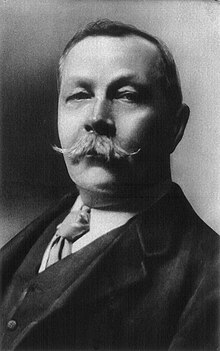About the Book: "The Adventure of the Noble Bachelor", one of the 56 short Sherlock Holmes stories written by British author Sir Arthur Conan Doyle, is the tenth of the twelve stories collected in The Adventures of Sherlock Holmes. The story was first published in Strand Magazine in April 1892.
About the Author: Arthur Ignatius Conan Doyle was born on 22 May 1859 at 11 Picardy Place, Edinburgh, Scotland. From 1876 to 1881, he studied medicine at the University of Edinburgh, including a period working in the town of Aston (now a district of Birmingham) and in Sheffield, as well as in Shropshire at Ruyton-XI-Towns. While studying, Doyle began writing short stories. His earliest extant fiction, "The Haunted Grange of Goresthorpe", was unsuccessfully submitted to Blackwood's Magazine. His first published piece "The Mystery of Sasassa Valley", a story set in South Africa, was printed in Chambers's Edinburgh Journal on 6 September 1879. On 20 September 1879, he published his first non-fiction article, "Gelsemium as a Poison" in the British Medical Journal. In 1882 he joined former classmate George Turnavine Budd as his partner at a medical practice in Plymouth, but their relationship proved difficult, and Doyle soon left to set up an independent practice. Arriving in Portsmouth in June of that year with less than £10 (£900 today) to his name, he set up a medical practice at 1 Bush Villas in Elm Grove, Southsea. The practice was initially not very successful. While waiting for patients, Doyle again began writing stories and composed his first novels, The Mystery of Cloomber, not published until 1888, and the unfinished Narrative of John Smith, which would go unpublished until 2011. He amassed a portfolio of short stories including "The Captain of the Pole-Star" and "J. Habakuk Jephson's Statement", both inspired by Doyle's time at sea, the latter of which popularized the mystery of the Mary Celeste and added fictional details such as the perfect condition of the ship (which had actually taken on water by the time it was discovered) and its boats remaining on board (the one boat was in fact missing) that have come to dominate popular accounts of the incident. Doyle struggled to find a publisher for his work. His first significant piece, A Study in Scarlet, was taken by Ward Lock Co. on 20 November 1886, giving Doyle £25 for all rights to the story. The piece appeared later that year in the Beeton's Christmas Annual and received good reviews in The Scotsman and the Glasgow Herald. The story featured the first appearance of Watson and Sherlock Holmes, partially modeled after his former university teacher Joseph Bell. Doyle wrote to him, "It is most certainly to you that I owe Sherlock Holmes ... Round the center of deduction and inference and observation which I have heard you inculcate I have tried to build up a man." Robert Louis Stevenson was able, even in faraway Samoa, to recognize the strong similarity between Joseph Bell and Sherlock Holmes: "My compliments on your very ingenious and very interesting adventures of Sherlock Holmes. ... Can this be my old friend Joe Bell?" Other authors sometimes suggest additional influences—for instance, the famous Edgar Allan Poe character C. Auguste Dupin. A sequel to A Study in Scarlet was commissioned and The Sign of the Four appeared in Lippincott's Magazine in February 1890, under agreement with the Ward Lock company. Doyle felt grievously exploited by Ward Lock as an author new to the publishing world and he left them. Short stories featuring Sherlock Holmes were published in the Strand Magazine. Doyle first began to write for the 'Strand' from his home at 2 Upper Wimpole Street, now marked by a memorial plaque. In this period, however, Holmes was not his sole subject and in 1893, he collaborated with J.M. Barrie on the libretto of Jane Annie. Doyle was found clutching his chest in the hall of Windlesham Manor, his house in Crowborough, East Sussex, on 7 July 1930. He died of a heart attack at the age of 71. His last words were directed toward his wife: "You are wonderful." At the time of his death, there was some controversy concerning his burial place, as he was avowedly not a Christian, considering himself a Spiritualist. He was first buried on 11 July 1930 in Windlesham rose garden. He was later reinterred together with his wife in Minstead churchyard in the New Forest, Hampshire. Carved wooden tablets to his memory and to the memory of his wife are held privately and are inaccessible to the public. That inscription reads, "Blade straight / Steel true / Arthur Conan Doyle / Born May 22nd 1859 / Passed On 7th July 1930." The epitaph on his gravestone in the churchyard reads, in part: "Steel true/Blade straight/Arthur Conan Doyle/Knight/Patriot, Physician, and man of letters". Undershaw, the home near Hindhead, Haslemere, south of London, that Doyle had built and lived in between October 1897 and September 1907, was a hotel and restaurant from 1924 until 2004. It was then bought by a developer and stood empty while conservationists and Doyle fans fought to preserve it. In 2012 the High Court ruled that the redevelopment permission be quashed because proper procedure had not been followed. A statue honours Doyle at Crowborough Cross in Crowborough, where he lived for 23 years. There is also a statue of Sherlock Holmes in Picardy Place, Edinburgh, close to the house where Doyle was born.
My Review: Another fascinating adventure from Sherlock Holmes short story series, this one with a very interesting plot: The story entails the disappearance of Hatty, Lord St. Simon's bride on the day of their marriage. She participates in the wedding, but disappears from the reception.
The events of the wedding day are most perplexing to Lord St. Simon as it seemed to him that his bride, Miss Hatty Doran of San Francisco, was full of enthusiasm about their impending marriage. St. Simon tells Holmes that he noticed a change in the young lady's mood just after the wedding ceremony. She was uncharacteristically sharp with him. The only thing out of the ordinary at the church where the wedding took place was Hatty's little accident: she dropped her wedding bouquet and a gentleman in the front pew picked it up and handed it back to her.
After the bridal party entered Hatty's father's house for the wedding breakfast, a former companion of St. Simon, the dancer Flora Millar, caused a disturbance at the door and was ejected. Hatty was seen talking to her maid upon arrival at the house; ten minutes into the wedding breakfast, Hatty claimed "a sudden indisposition" and retired to her room. A short time later, it was discovered that she had left the house.
There are many questions that Holmes must sift through. Who was that woman trying to get in to the wedding breakfast? Who was that man in the front pew? Who was that man seen going into Hyde Park with Hatty? Why were Hatty's wedding dress and ring found washed up on the shore of the Serpentine? What had become of her?
For Holmes it proves rather an elementary case, for he has dealt with similar cases and this one is not so complex to unravel, despite the confusion it causes Dr. Watson and Inspector Lestrade. Holmes finds Hatty and the strange man from the front pew, and the dénouement takes the form of Holmes having Hatty explain herself to Lord Robert. Hatty and the mystery man, Francis H. Moulton, were husband and wife. They parted on the day of their wedding so that he could try to amass a fortune by prospecting. He was reported killed in an Apache raid on a mining camp where he was working. Hatty had given him up for dead, met Lord Robert, and decided to marry him, even though her heart still belonged to Frank. Frank had only been taken prisoner by the Apache raiders, and he escaped and tracked Hatty to London. He arrived at the church in time for the ceremony and she recognized him instantly. Rather than have her make a scene at the church, he gestured her to be silent, and wrote a note which he slipped to her as he returned her bouquet. She had wanted to abscond without ever telling anybody, but Holmes had tracked them down and convinced them that it would be better to have the full truth. Lord Robert is unmoved by Hatty's apologies and feels that he has been very ill used.
I recommend this book to the permanent library of all readers that enjoy a very well written mystery short story.
If you read this review, fell free to leave a comment.



No comments:
Post a Comment